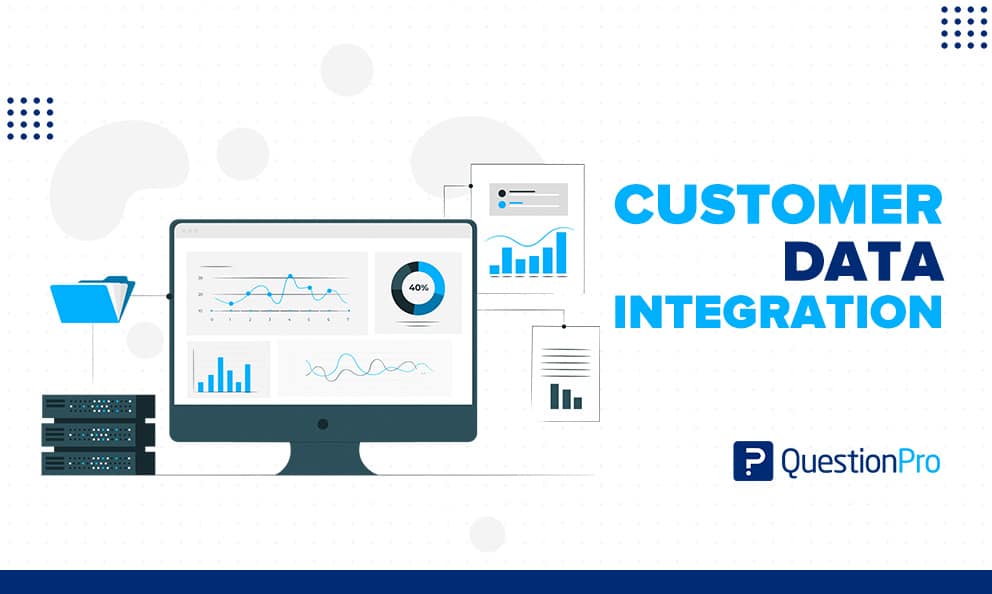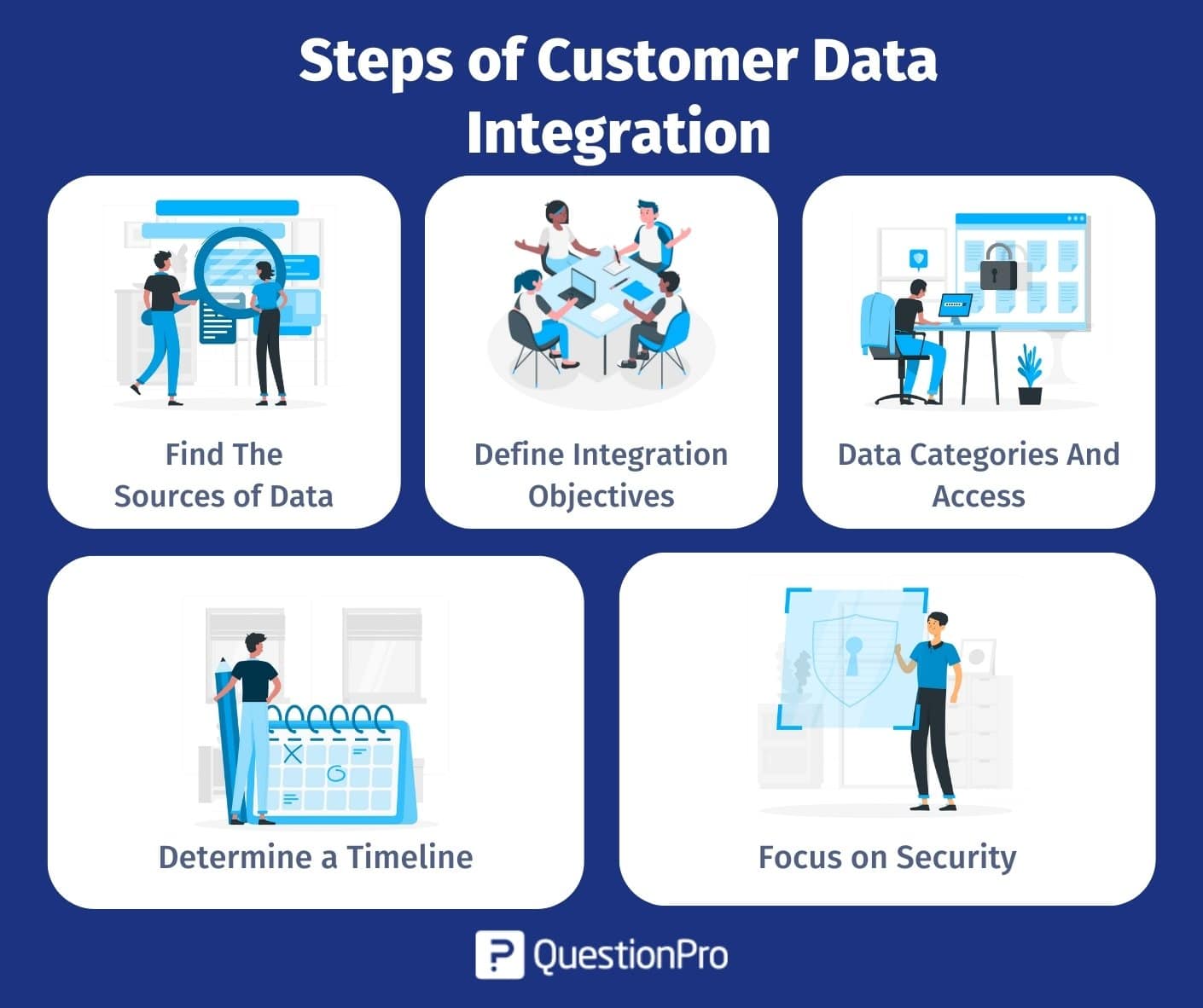
Customer data integration (CDI) is the process of maintaining customer data from several sources across a company. Disorganized data can negatively impact your company’s operations. Properly collected and processed customer data can provide a variety of beneficial insights for the business.
Customer data management is necessary to build relationships and move customers through the sales funnel. Its integration improves the impact of your work process on the organization’s bottom line. Let’s define CDI, its benefits, and some steps to get started.
What is customer data integration?
Customer data integration is the process of gathering customer data from a variety of sources and structuring it to be shared easily with members of a company’s various departments.
Its purpose is to build a single source for high-quality data that can be used for further analysis, administration, and deployment. This data may contain contact information, financial details about customers, information gathered through marketing operations, and so on.
CDI assists your company in identifying and utilizing a distinct source of reality for all technologies that interact with your customers. It’s necessary to manage client relations and service and develop a strategy for optimizing company activities.
LEARN ABOUT: Client Management
Customer data integration benefits
Customer data integration gives your company a 360-degree overview of your customers. It provides a detailed view of your customer’s purchase habits, locations, and other information.
Sales and marketing teams benefit from this insight since it helps them concentrate their efforts on the most profitable areas. Here are some ways that customer data integration might help your company:
Creates new opportunities
Integrating customer data is beneficial for identifying new opportunities. Customer needs are always changing. As a result, it is critical to integrate data constantly. Customer data analysis can give information on how customers’ wants are fulfilled.
You can utilize customer data to categorize your customers by separating them into smaller groups of more closely related people. This will help you focus your marketing messages better and obtain greater results.
Suppose any company wants to offer an existing product with a limited budget. In that case, the customer data integration strategy helps identify marketing leads and determine whether it is cost-effective.
Examines customer behavior
Integrating customer data allows you to investigate customer behavior in a variety of ways. It is a vital aspect of your customer data management strategy and helps to take a new look at your target audience.
You can change your whole sales and marketing strategy if you know how customers think, feel, and make decisions. Analytics is the key to success because it helps buyers along their customer journey and helps keep clients coming up with new offers.
Estimate future sales and industry trends
Customer data identifies popular product categories at any specific time. You can utilize this to get a competitive advantage. If you know a lot about your customers and their needs, you can predict how sales will go in the future. By looking at past and present customer information, you can stay on top of industry trends and plan ahead for what customers want.
Reach out to the specific audience
Customer data integration can help you better understand your customer’s purchasing habits and preferences. Your marketing efforts can be tailored to meet those needs. This eliminates the time-consuming process of assuming which customers to target.
Ensures data accuracy
Accurate data is critical for effective audience analysis and decision-making. Customer data integration helps you analyze customer data. You can eliminate the problematic data and collect high-quality customer data. You can make sure that your data is correct and that your decisions are based on good information.
Types of customer data integration
Customer Data Integration (CDI) encompasses three primary types, each serving a distinct purpose in managing and unifying customer data:
Data Consolidation
Data consolidation involves the efficient integration of data from diverse sources into a centralized data warehouse. Utilizing data integration tools automates the extraction and placement of data, ensuring a standardized integration approach. The main advantage lies in maximizing the utility of integrated data by creating a unified and standardized repository.
Data Propagation
In data propagation, the goal is to duplicate a dataset, making the same data available in both its original source and a new destination. This involves creating copies of data to enable parallel usage in different systems or tools. However, caution is necessary to prevent the unintentional creation of data silos. A data silo could hinder the extraction of valuable insights.
Data Federation
Data federation aims to provide a unified view of all available data while segregating data sources. Unlike data consolidation, data federation maintains separation among data sources, making it challenging to dissect, manage, and customize information freely.
Steps involved in the integration of customer data
The data integration process is not a one-time event. This means you need to follow a series of steps to get it right. If you want to create a unified view of your customers, the following steps must be followed.

Find the sources of data
The first step toward a single customer view is gathering important customer data infrastructure from all sources, such as transactions, product choices, engagement data, and retail data.
Before combining data, you need to figure out where the most important data comes from. The data sources you choose should work with the way you plan to use them. At this stage, surveys, reviews, emails, etc., are all important places to look for data. Each of these sources of data gives important information about customers.
Define integration objectives
You will perform poorly if you don’t set a clear and logical goal for integrating your customer data. Find out why it’s good for businesses to combine their customer data and set up metrics to see if your company is meeting its business goals. Spend some time determining your current and future customer data integration needs. CDI is great for both long-term and short-term goals, so keep that in mind.
Data categories and access
Find out who can see information about your customers and why they should be able to. It’s important to figure out who will be in charge of the integration process and their responsibilities. List down who will be on this team. This will make it easier to keep the integrity of the combined customer data.
Determine a timeline
It would help if you made a timeline for the implementation process. This will help you start managing client data in the best way possible. Depending on what tools you use, the timetable will be changed. With the help of an advanced tool, you can rearrange the timeline. If you have to deal with a hard game, the process could take a long time to finish.
Focus on security
When working with any data, security is absolutely essential. Data breaches and leaks could have significant consequences during the implementation of CDI.
These effects could include an impact on your company’s budget and credibility and a negative impact on the customer experience. You must maintain the data’s confidentiality as you move forward with the integration of customer information.
Challenges in integrating customer data
Integrating customer data can be a complex process that involves merging information from various sources to create a unified and comprehensive view of each customer. While this integration can bring about numerous benefits, there are several challenges that organizations often face in the process:
Data quality issues
- Inconsistency: Data may be inconsistent across different sources, with variations in formats, naming conventions, and data structures.
- Accuracy: The data may have inaccuracies or outdated information, leading to a lack of trust in the integrated dataset.
- Completeness: Missing or incomplete data can hinder the creation of a holistic customer profile.
Data security and privacy concerns
- Compliance: Organizations need to adhere to various data protection regulations, such as GDPR, HIPAA, or CCPA. Ensuring compliance while integrating customer data is crucial to avoid legal issues and maintain customer trust.
- Security: The process of integrating data poses security risks, and organizations must implement robust security measures to protect sensitive customer information from unauthorized access or breaches.
Integration of diverse data sources
- Multiple formats: Customer data may exist in various formats, including structured and unstructured data. Integrating these diverse formats can be challenging.
- API compatibility: Ensuring that different systems and applications can communicate and share data through compatible APIs is crucial for seamless integration.
Scalability
- Volume: As the volume of customer data increases, the complexity of integration grows. Scalability issues may arise, requiring organizations to invest in systems that can handle large datasets efficiently.
Data Governance
- Ownership and accountability: Determining ownership and accountability for integrated data is essential. Lack of clear governance can lead to confusion and errors in managing customer information.
- Data standards: Establishing and enforcing data standards is crucial for maintaining consistency and quality across integrated datasets.
How Question Pro helps in customer data integration?
QuestionPro is a survey and research platform that helps businesses collect and analyze customer feedback. While it may not be a direct tool for customer data integration, it can play a role in the overall process. Here’s a simple way to understand how QuestionPro can contribute to customer data integration:
Data collection
QuestionPro allows businesses to create surveys and collect valuable customer feedback. These surveys can include questions about preferences, satisfaction levels, and other relevant information.
Customer insights
Businesses gain insights into customer behavior, preferences, and opinions by analyzing the survey responses. This data becomes a valuable asset in understanding the customer base.
Integration with CRM systems
Although QuestionPro may not directly handle data integration, the collected survey data can be integrated into Customer Relationship Management (CRM) systems. CRM systems store and manage customer information, providing a comprehensive view of each customer.
Enhancing customer profiles
The survey data collected through QuestionPro can be used to enrich existing customer profiles in CRM systems. This contributes to a more holistic understanding of each customer, helping businesses tailor their products and services.
Informed decision-making
Businesses can make more informed decisions with integrated customer data from surveys and CRM systems. For example, marketing strategies, product development, and customer engagement initiatives can be better aligned with customer preferences.
Conclusion
Lastly, please choose a plan to carry out customer data integration that includes both the objective of implementation and how its success will be measured.
With a better understanding of the benefits and steps of integrating customer data, you can choose a data integration tool that will help you understand your customers more clearly. Integration of customer data is an important part of managing your data.
Making successful decisions without a central location for valuable data cannot be easy. QuestionPro CX provides its users with some of the most cutting-edge and comprehensive tools for the customer experience that are currently on the market. Using QuestionPro CX right now can provide invaluable insights into your customers’ thoughts.







